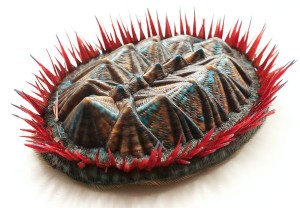A spiky, well-armored mollusk that lived in the ocean 390 million years ago has been brought back to life with the help of 3-D printers.
Less than an inch long, the oval-shaped creature—a species of so-called multiplacophoran dubbed Protobalanus spinicoronatus—was previously known from only a few rare and incomplete specimens, which made for inaccurate reconstructions.
“The original reconstruction was made where the plates were arranged in a long row, almost like a long worm with 17 plates down its back,” said study co-author Jakob Vinther, a paleontologist at the University of Texas at Austin.
The latest P. spinicoronatus model is based on the most complete known fossil of a multiplacophoran, discovered in 2001 in northern Ohio. Partially covered in rock, the animal’s shell and spikes had become fragmented as it decayed.
To reassemble the specimen, the team made a three-dimensional model of the broken fossil using a technology similar to medical CT scanning. They then painstakingly pieced the broken fragments of the digital fossil back together. Fossils have been digitally scanned before, Vinther said, but the new study is among the first to use the technology to reassemble a fossil that had been so badly fragmented.
The reconstruction revealed that the interlocking plates that made up the creature’s armor were actually arranged in two parallel rows, instead of one long row—the first step in re-creating what team member Esben Horn likens to a “movie monster.”
Bringing a Monster to Life
Next the team used the digitally restored copy of the fossil to create a physical model using a 3-D printer. Three-dimensional printers use computer models as guides as the machines lay down successive layers of soft material which gradually hardens.
Instead of creating a life-size version of the fossil, though, the researchers enlarged it by about 12 times, until it could be held in the palm of a hand.
Vinther says they did this to get a better feel for what the creature looked like and how its pieces fit together.
“When you have a specimen that is that small, it’s hard to get a feeling for its morphology,” or structure, he said. “With this large model, you can touch it with your fingers, and that makes a big difference.”
As a final step in bringing multiplacophoran back to life, the team sent their printout to Horn, owner of the modelmaking company 10 Tons in Copenhagen.
Esben used sculpture to create a multicolored, textured model of the creature using clay, resin, and silicon to show what the creature may have looked like millions of years ago, when it crept across the seafloor using its single, suction-like foot.
Vinther’s team had determined multiplacophorans were distant relatives of modern-day marine mollusks called chitons, so Horn used chitons as a guide when choosing colors.
“Hopefully this one can inspire a kid to see it and say, Wow, this looks like a movie monster—this is interesting. And then hopefully they can continue being paleontologists,” Esben said in a video.
Ancient Mollusk Had Many Predators?
The new model also reveals that P. spinicoronatus was more heavily armored than other mollusks living at the time, and in fact resembled some modern chitons, which live in shallow, exposed environments where there are a lot of predators—as the team believes was the case for the prehistoric mollusk too.
Multiplacophoran’s hunters would likely have included jawed fish and beaked cephalopods similar to squid and octopuses—both of which had recently evolved.
“It was a really exciting time,” Vinther said, “because there was a lot going on.”
The new mollusk model is detailed in the September 18 issue of the journal Paleontology.



 September 24th, 2012
September 24th, 2012  riffin
riffin 
 Posted in
Posted in  Tags:
Tags: 